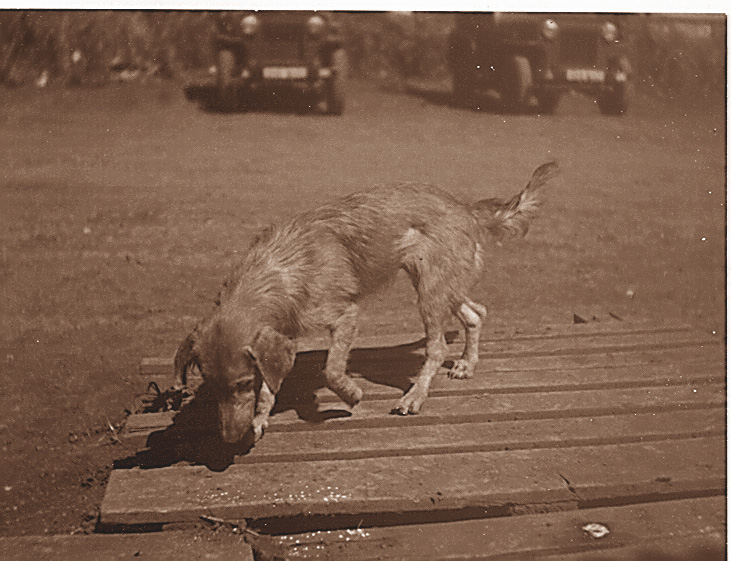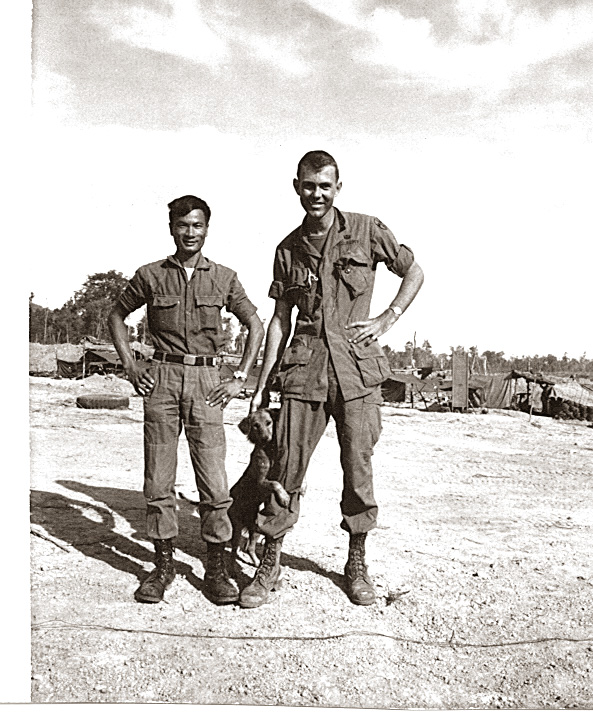
This is a war story. It is not a story of blood and guts, but of puppies and love. I have always felt it would make a great Disney movie.
About November 1967, one of my NCOs, SSG Ketchel (a great American soldier who was twice wounded, the second time very seriously), was in Xuan Loc between field operations, and brought a stray dog back to our team for a mascot. Someone named her Ruby.

Ruby
Ruby was young and not in great shape. She was undernourished and covered with mange. We treated her mange using home remedies (motor oil applied lightly), and it worked. We shared with her what we had. Since we were with the South Vietnamese, our ration was usually rice, with a bit of dried fish or meat, and a c-ration now and then. The rations were adequate but, from an American GI's perspective, not great. Ruby, of course, didn't mind. After all she was Vietnamese, and she returned our affection, as dogs do, tenfold. She was a small, wiry dog, full of fun and love, with a great sense of humor.
Most of the time, Ruby remained in our base area while we were in the jungle, and she was always there to greet us when we returned after a few days, or weeks, in the field. We also took her to forward launch points and fire bases. She accompanied us when she could, sharing our fare and adventures. She was a real member of the team, and by the way, the only girl.
We were in our base camp in Xuan Loc in late January 1968 when the communist forces launched the now historic Tet Offensive. Attacks began in our area during the day, I believe on the 31st of January, when the Viet Cong probed the defenses of the city from two directions. After a brief flurry, the fighting faded. However, that was just the initial attack. At about 11 p.m., the VC attacked in earnest.
Xuan Loc was the Province Capital of Long Thanh Province, and a rather large town by Vietnamese standards. It was also the Headquarters of the 18th ARVN Division, (Army of the Republic of South Vietnam), of which my battalion was a part. That made it major communist target. The city was defended primarily by South Vietnamese infantry, but also located in the city were two U.S. artillery units that provided fire support to the surrounding area.
The attack on our unit was initiated with a horrendous mortar barrage. We had little cover since we had just moved into a new area and did not yet have proper protective bunkers. The mortar barrage was followed by a ground assault in our sector and general attacks throughout the town, which ebbed and flowed all night. Morning found us clearing the town of communist elements that had succeeded in penetrating our very loose perimeter during the night--a task of very "high adventure." During this time, although we thought of Ruby, we did not see her, and we were simply too occupied to search for her. The fighting went on for three days and nights. We could not keep the communists from penetrating the city at night, but during the day, they could not hold what they had gained.
When the attacks finally were exhausted at great cost to the enemy, we had time to collect ourselves, and we began to make a concerted effort to find out what had become of Ruby. I had convinced myself that she had been killed in the initial mortar barrage or subsequent fighting.
About a week later, one of our folks was visiting the U.S. artillery unit just down the road from our compound, and he found Ruby, alive and well. She had moved in with a male mascot dog of the U.S. unit "Blockhead." I realized that what had probably happened was that Ruby had become terrified in the confusion and noise of the initial attack. She had wisely fled, and probably unintentionally reached the U.S. unit. There she had met her new companion, who, coincidently, had his own sandbagged bunker (doghouse), situated right outside the U.S. mess hall. His home was secure and well protected, and his fare was considerably better than oursósteak now and then and other tasty morsels from the U.S. field kitchen.
Although we brought Ruby back to our compound, her heart was now clearly elsewhere. She would stay with us a couple of days and then return to Blockhead. After about the third time of retrieving her, we realized we were no longer her "home." She stayed only long enough for proper farewells and moved in permanently with Blockhead.
Over the years, as I have thought about Ruby, I have always liked to think that in the middle of the chaos, noise, danger, and confusion of battle, Ruby found true love. I can only hope it was not the material things about Blockhead's life that attracted her--the sandbags, overhead cover, and good foodóbut that it was really a deeper, spiritual attraction. But I'm sure she and Blockhead lived happily ever after.

Tuc (at left), an ARVN regular, and I, with Ruby affectionately attached to my leg, in December 1967
Contact Mac Dorsey